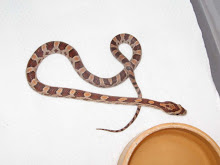How to Handle a Pet Snake - Handling TipsWelcome to the reptile care blog, where you can learn how to care for a variety of snake and lizard species. Now, on to today's lesson.-->
I remember when I bought my first pet snake, many moons ago. I was frustrated that none of the snake care manuals talked about handling the snake. Or not much, anyway. It’s easy to understand why — the authors were expert snake handlers, and may have forgotten about the uncertainty they had the first time they picked up their new snake.
But I know for a fact that handling a pet snake is a topic of great concern among first-time keepers. People email me all the time asking about this very subject. So I’ve created a short lesson to address the subject. Even if you already have a pet snake, and you’ve been handling it on a regular basis, I recommend that you read this entire post. I promise you’ll learn something new.
It’s Okay to Be Nervous at First
If you are nervous about picking your snake up from its cage for the first time, you can take solace in the fact that you are not alone. I would venture an unscientific guess that 98% of keepers were nervous about picking up their pet snakes for the first time, after bringing the animal home.
So let’s begin this article by making one thing clear — it’s okay to be nervous when you handle your pet for the first time, or even the first few times. Most people are. But I promise you’ll get over it with time and repetition.
Picking Your Snake Up
You might think that picking up a snake from its cage is a no-brainer. After all, you just reach in and grab it, right? Well, sort of. In reality, there are certain dos and don’ts about lifting a pet snake from its cage. Let’s start with the things you should do:
Depending on the type of snake you’re keeping, you might want to use a small to medium-sized snake hook to lift your pet from its cage. This may or may not be necessary, depending on the temperament of your snake. I use a hook for some of my snakes, but not for others. It’s an easy way to pick up a snake from a distance, and it’s perfectly safe for both you and your pet. When my snakes are out “cruising” around their cages, and I need to pick them up, I sometimes use a small snake hook (see image below) to get hold of them initially. Then I gently grab hold with the other hand and eventually toss the hook aside.
Image Notes: This is what I mean by a “snake hook,” if you’re not familiar with the term. You can buy one from a website such as Tongs.com, or you can make your own (if you’re handy).
On the other hand, if the snake is hiding when I go to retrieve it, I’ll just pick it straight up with my hands. The snake’s body language will dictate which method I use when picking it up.
Here’s why I use the hook method at times:
I feed my snakes inside their cages, as opposed to moving them to a separate feeding box the way some people do. Because of this, a pet snake might mistake me reaching into the cage as an offering of food. The hook is a way of telling the snake, “It’s not food time … it’s handling time.”
I only use the hook when the snakes are out in the open and facing the cage opening. When a pet snake is under its hide, it’s even easier to pick up. Just lift the hide (slowly so you don’t startle it too much), gently grab hold of the mid-body area, and lift the animal using the other hand to support it as well.
Picking up a pet snake that’s facing / moving away from you is also very simple. Gently buy firmly grab the snake around mid-body, lift it up, and then support it with both hands. Just be prepared for it to try and crawl away when you first grab it, especially if it’s a young snake. Young snakes tend to exhibit more “flight” behavior, or escapism. But this will diminish over time and with regular handling.
Image Notes: This is one of my ball pythons, and it’s the proper way to hold one. Notice that I’m using both hands to support the snake, and notice how the ball python is wrapping around my wrist for extra stability.
More Tips for Handling a Pet Snake
Always support as much of the animal as possible, focusing on the mid-body area. Pet snakes tolerate handling better when they feel safe and secure within your grasp.
Never try to grab or pick up a pet snake by its head. Nearly all species are “head shy,” meaning they don’t like for their heads to be touched. This method could result in being bitten.
Don’t pick up a snake by the tail alone. It could spin or thrash around in your grip, possibly injuring itself in the process. You’ll find that your pet snake relaxes into your grip more if you lift and support it from the mid-body area. There’s a reason I keep stressing that point over and over.
Baby snakes will sometimes put on quite a display when they feel threatened, even “rattling” their tails inside the enclosure. Sometimes they’ll hiss and puff themselves up, and they may even musk or defecate as you try to retrieve them. Just remember that it’s a harmless animal to you, despite the dramatic display. Be confident and consistent when handling your pet snake, and this behavior will soon disappear.
Always think of your snake’s safety first when handling. Use common sense and be responsible.
I hope this article helps you handle your pet like a professional.


